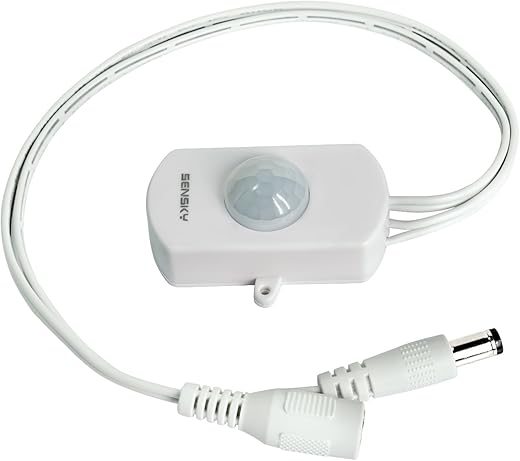







Understanding Motion Sensor Control: The Future of Smart Living
In today’s fast-paced world, technology is evolving at a remarkable rate, and one of the standout features transforming our homes is motion sensor control. But what exactly is it? Imagine walking into a room, and the lights automatically turn on, or your thermostat adjusts to your preferred temperature as you approach. Sounds like magic, right? In reality, it’s all thanks to innovative motion sensor technology. Let’s dive deeper into how these devices work and how they can enhance your everyday life.
What Are Motion Sensors?
Motion sensors are electronic devices that detect and respond to movement within a designated area. They utilize various technologies, such as passive infrared (PIR), ultrasonic, and microwave sensors, each with its unique method of detecting motion. For instance, a PIR sensor detects body heat, making it ideal for indoor environments like living rooms and hallways. In contrast, ultrasonic sensors emit sound waves and monitor their return, functioning well in larger areas like warehouses or outdoor settings.
How Do Motion Sensors Work?
At the heart of motion sensors lies the simple principle of change detection. When something moves within the sensor’s range, it triggers an electrical signal. This signal can then activate various devices, such as lights, alarms, or even automated systems. Think of it as a watchful guardian; it keeps an eye on your space and reacts swiftly to any changes.
For example, when you enter a room, the sensor detects your movement and sends a signal to the lighting system, illuminating the space without you having to flip a switch. This not only adds convenience but also enhances energy efficiency, as lights can be programmed to turn off automatically when no one is present.
The Benefits of Motion Sensor Control
1. **Energy Efficiency**: One of the most significant advantages of motion sensors is their ability to conserve energy. By ensuring that lights and devices are only active when needed, you can significantly reduce your electricity bills. Imagine a world where your home is smart enough to turn off lights in empty rooms, just like a diligent housekeeper!
2. **Enhanced Security**: Motion sensors also play a crucial role in home security. By integrating these devices with security systems, you can receive alerts whenever unexpected movement is detected. It’s akin to having a virtual watchdog that never sleeps.
3. **Convenience and Comfort**: Picture this: you’re carrying groceries and your hands are full. With a motion sensor light, you don’t have to fumble for a switch; the light activates as you walk in. This level of convenience can significantly enhance daily living, especially for those with mobility issues.
4. **Versatile Applications**: Whether you’re outfitting your home, office, or even outdoor spaces, motion sensors can be used in various ways. From automatic porch lights to smart thermostats that adjust based on presence, the possibilities are endless.
Choosing the Right Motion Sensor
Selecting the right motion sensor for your needs can be daunting, but it doesn’t have to be. Here are a few considerations to guide your choice:
– **Type of Sensor**: Decide between PIR, ultrasonic, or microwave sensors based on the environment they will be used in. For indoor use, PIR sensors are often the best fit, while larger outdoor areas might benefit from microwave sensors.
– **Coverage Area**: Consider the range of the sensor. Some sensors cover a small area, while others can monitor large spaces. Measure your space and choose accordingly.
– **Integration with Smart Home Systems**: If you have a smart home setup, look for motion sensors compatible with your system. This allows for seamless integration and greater control.
Installation and Maintenance Tips
Installing motion sensors can be a straightforward process, but there are a few tips to ensure optimal performance:
– **Positioning**: Install the sensor at a height that maximizes coverage while minimizing obstructions. Corners of rooms or entrances are often ideal locations.
– **Regular Testing**: Periodically check the sensors to ensure they are functioning correctly. Dust and debris can obstruct their view, leading to poor performance.
– **Battery Replacement**: If you’re using battery-operated sensors, keep an eye on battery life to ensure uninterrupted functionality.
Conclusion
Motion sensor control is not just a trend; it’s a glimpse into the future of home automation. By understanding how these devices work and their myriad benefits, you can create a more efficient, secure, and convenient living space. So why not embrace this technology? After all, who wouldn’t want a home that anticipates their needs?
FAQs
1. Can motion sensors work outdoors?
Yes, many motion sensors are specifically designed for outdoor use, featuring weather-resistant casings and wider coverage areas to monitor outdoor spaces effectively.
2. How do I maintain my motion sensors?
Regularly clean the sensors to prevent dust buildup and test their functionality periodically. If battery-operated, replace the batteries as needed to ensure they remain operational.
3. Are motion sensors safe for pets?
Yes, many modern motion sensors can differentiate between human movement and pet movement, making them suitable for homes with pets. However, it’s essential to choose the right type of sensor to minimize false alarms.
